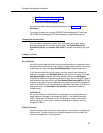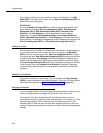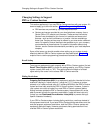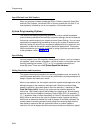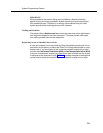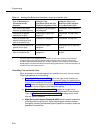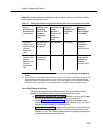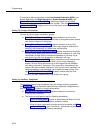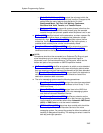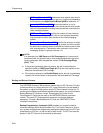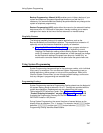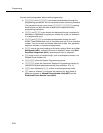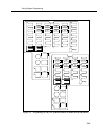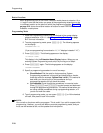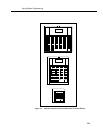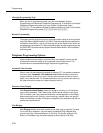
System Programming Options
2-15
— Music-On-Hold Volume (#614) controls the volume at which the
music plays when the Music-On-Hold jack is active. Changes to this
setting affect the many features that use Music-On-Hold:
Background Music, Call Park, Call Waiting, Conference,
Exclusive Hold, Hold, Transfer, and Transfer Return.
— Background Music lets users with system phones (other than the
MDC 9000 or TransTalk 9000-series phones) play the recorded
material through their phone’s speaker when the phone is not in use.
■ Hotline (#603) identifies internal hotline extensions, so when a person lifts
the handset of the hotline phone, a predetermined
extension number
automatically rings. External Hotline (#311) identifies external hotline
extensions, so when a person lifts the handset of the hotline phone, a
predetermined
outside phone number
is automatically dialed.
■ Doorphone Extension (#604 and #605) identifies extensions to which
doorphones are connected. Doorphone Alert Extensions (#606)
identifies extensions that signal when the doorphone button is pressed.
NOTE:
Doorphones should not be connected to an Enhanced Tip Ring only port
since doorphones rely on receiving a forward disconnect signal to
disconnect a call. Connect doorphones to Tip Ring ports, which are the
bottom two ports of any processor or 362EC expansion module.
■ AA Extensions (#607) identifies an extension to which an auto attendant
is connected. This lets the system notify users with display phones when
they are receiving a call that has been transferred from the auto attendant.
Also, Transfer Return Extension (#306) lets you identify the extension to
which a call transferred by the auto attendant should be routed if the
destination extension does not answer.
■ The voice messaging system uses the following procedures:
— Hunt Group Extensions (#505) assigns the extensions associated
with the voice messaging system hardware to Hunt Group 7—the
VMS Hunt Group.
— Group Call Distribution (#206) assigns lines to the VMS Hunt
Group so calls can ring directly into the voice messaging system
and receive Automated Attendant Service.
— Line Coverage Extension (#208) identifies an extension as the
owner of a specific outside line so calls on that line can ring directly
into the owner’s voice mailbox when either Automatic VMS Cover
(#310) or VMS Cover is on at the owner’s extension.
— VMS Hunt Delay (#506) determines when outside calls should be
answered by the Automated Attendant Service of the voice
messaging system. You can set the system for either immediate call
handling or delayed call handling. The setting you select is used for
both day and night operation.



